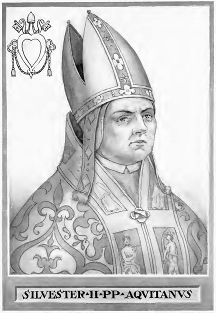The Failed chronology adjustment of Silvester II.
Gerbert of Aurillac
(†1003 ce.):
The
most important scholar of his time and teacher of the young Otto III
had accompanied the emperor to Rome and had been appointed by the
emperor as Archbishop of Ravenna. As Pope Silvester II, after the
sudden death of his predecessor, the 28-year-old Gregory V, he led the
Roman Church into a new millennium of the Alexander era, after which
Christianity and Jews counted the years [al Biruni].
Already in 1241Alx|930ce Aaron Ben Ascher had published the Masoretic
Tanach, which had been worked out under consideration of astronomy.
The adaptation of the Christian traditions to the common standard of astronomers was therefore overdue:
|

|
As the chronicle of Edessa reported, Christ was born in
the 307th year of the Seleucid era. Surprisingly, it turned out that
the traditions apparently lacked a 'Great Year' [Hipparchos] of 304
years. Furthermore, the lunar cycles of Callippos and Hipparchos had
apparently been exchanged. Since the Indiction (Roman tax year) counted
from 1 to 15 without interruption since Augustus until the present,
another 7 years were missing in the tradition: Apparently an evil ruler
(Phocas) had fallen under the of Damnatio Memoriae. All this could easily be corrected with a few 'additions' to the surviving texts.
When the Pope celebrated Holy Mass on Ascension Day 1003ce in the
church of Santa Croce di Gerusalemme, near the former palace of the
emperor's mother Helena, he collapsed. At last he gave order to
dismember his 'cursed body' after his death and then bury it
anonymously. Thus the rumour persisted that he had sold his soul to the
devil before. But what could have that much shaken this pope? The Roman
emperor's mother Helena was in fact the Greek-born daughter (†18.10.33
AD) of Marcus Vipsanius Agrippa. She was the owner of the palace and S. Croce was her chapel. However, she was the mother of Caligula and not of Constantine the Great.NB:
Agrippina the Elder died on 18.10.33 AD, Helena died on 18.8.330 CE. If
the 61 missing leap days of the calendar before -44 AD (253 ce) are
considered, then both would have died on the same day!
The Pope's mass had put the Christian mother of
Constantine on a par with the pagan empress who had lived three
centuries earlier! Too late, Gerbert had realized that there was no
longer any prospect of finding verifiable proof of the Savior's
existence and thus for the truth of his teaching.
From his predecessor Gregory V, Pope Silvester II had taken over the
imperial commission to 'purge the centuries'. With some pressure on the
dioceses he had finally achieved this. The turn of the millennium,
celebrated by the Pope as a secular year, provided contemporaries with
the obvious reference for counting the years. Until then, the year of
Jesus' birth had only been a time marker in antiquity, whose year was
determined by the Greek's count, various worldly figures or the Roman
cycles of indications.
In England there had apparently been some resistance to
the specifications from Rome and the "unexpected outbreak of
indignation and a state of affairs threatening danger" (Vita
Bonifatii):
On 15 October 705 the Anglo-Saxon political institution of the
Witenagemots (Council of Wise Men) met in Brentford near London to
discuss the "propagandistic commitment to Rome-oriented church habits"
promoted by Bishop Aldhelm.
(Theologische Realenzyklopädie, volume VII, p. 69).
With the Continuatio Bedae the historiography ends there in 766 AD for three centuries up to the Norman conquest in 1066 CE.
"Eadmer v. Canterbury († 1124) omits [in his Historia Novorum in
Anglia] a total of 223 years after Beda, which he thought were not
worth mentioning and during this interval history therefore limps
without the support of written history". William of
Malmsbury
[Another 118 years (616-734 AD) were taken over from Bede, which doubles 44 years (913-957 CE) - overall 297 years are missing].
-------------
Quellen:
Hock,
C.F.,
(1837): Gerbert oder Papst Silvester II und sein
Jahrhundert, Wien
Laszlo Renate
(2006): Rätselhafte Zeitsprünge in England, Zeitensprünge
3/2006 S.
689.
Lausser, A. (1866): Gerbert – Étude
historique sur le dixième siècle, Aurillac, Neuaufl.1966
Leo v. Vercelli (998) an Gregor V.: "Auf Befehl des Kaisers
erschafft der Papst Jahrhunderte"
hek 1/2015
